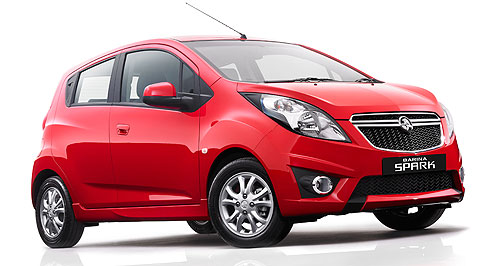New models - Holden - Barina SparkFirst drive: Auto Sparks up baby Holden BarinaThat's better: Holden now offers a automatic transmission alternative to the manual gearbox in the Barina Spark More power, auto and a host of minor improvements recharge Holden’s Barina Spark28 Nov 2012 WITH automatic transmission now available along with more features and subtly improved styling inside and out, Holden is hoping the revamped Barina Spark baby will rattle the Nissan Micra, Suzuki Alto, Hyundai i20 and even the Volkswagen Up in the sub-B bottom end of the light-car class. On sale from January and priced from an identical $12,490 plus on-road costs for the five-speed manual and $2000 more for the new four-speed automatic, the Korean-made five-door hatchback has been pared back to a single model now that the CDX flagship has been axed in the MJ Series II range. With 7252 sales to the end of October, the Micra is the clear leader in the cheap end of the market, ahead of the Alto (3382) and Spark (1168) – although the latter has struggled without automatic availability since its October 2010 launch. As two out of three light-car buyers prefer automatic, Holden believes the Spark can overtake the Alto next year, although whether it can catch the Micra for volume is unknown. Although sales projections are confidential, the Holden marketing manager for small, medium and electric cars Emma Pinwill says she is confident the auto’s sales will easily eclipse the manual’s to give the range newfound impetus. “We expect the auto to really give the Spark a boost,” she said. Subtle styling changes include a new grille, front bumper, headlights, tail-lights, rear roof spoiler, side skirts and alloy wheels, as well as a couple of fresh colours, while the instrument cluster, materials and trim have been revised. Choosing the new auto brings more power, thanks to a 1.25-litre twin-cam, 16-valve, four-cylinder petrol engine with dual continuous variable cam phasing, delivering 63kW of power at 6400rpm and 113Nm of torque at 4200rpm on standard 91 RON unleaded petrol, averaging 5.8 litres per 100 kilometres and 139g/km of carbon dioxide emissions. In contrast, the Spark manual continues with the old 1.2-litre four-pot unit, producing 59kW at 6400rpm and 107Nm at 4800rpm, along with 5.2L/100km and 125g/km. Going auto brings a number of benefits over the manual, including the fuel-saving neutral idle control and electric power steering tuned in Australia by Holden (although oddly the manual sticks with the old hydraulic steering). Bluetooth connectivity with steering wheel mounted phone controls, and a flip-key are also Spark auto-only exclusives for now. On both models, buyers will continue to receive 256mm front discs and 200mm rear drum brakes, as well as ABS with electronic brake-force distribution, traction control, six airbags (front, side and curtain) and an anti-intrusion collapsing pedal system. However, the Spark cannot match the Up in offering five-star safety, sticking to its four-star ANCAP result. Furthermore, ISOFIX restraints won’t make it on the Spark until the second quarter of 2013. At 3595mm long, 1597mm wide and 1522mm high, the Spark is considerably smaller than the TM Barina, sitting on a 2375mm wheelbase, and offering luggage space ranging from 170 litres to 568L with the rear seat folded. Like before, the 2013 model employs the heavily revised T200 platform under the 2002 Daewoo Kalos and its 2005 TK Barina offshoot, rather than the TM’s Opel Corsa-derived Gamma II chassis. Convention rules – the front suspension is by MacPherson struts and coils, while a torsion beam is located out back. Holden’s capped price servicing at a maximum of $185 per service covers the first four standard scheduled logbook services for the first three years or 60,000km. Holden new model pricing*
 Quick tests |
|
||||||||
























Facebook Twitter Instagram